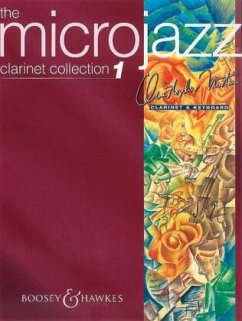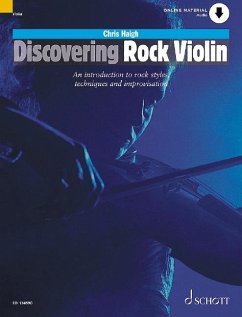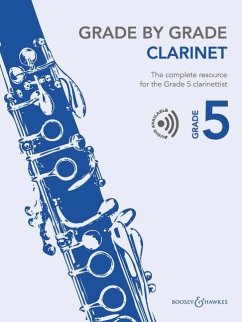
Developing Jazz Technique for Clarinet
Versandkostenfrei!
Nicht lieferbar
Following on from the best-selling Jazz Method for Clarinet, "Developing Jazz Technique for Clarinet" will help the intermediate player take their jazz skills to a new level. The pieces are written in a variety of styles, including blues, swing, New Orleans, ragtime, jazz waltz, bossa nova, samba, salsa, calypso, reggae and South African. Particular emphasis is given to helping the student improvise over chord sequences, such as the II-V-I progression. Idiomatic effects like vibrato, subtone, glissandi and 'bending' notes are dealt with, and there is a special chapter on overtones. Several new...
Following on from the best-selling Jazz Method for Clarinet, "Developing Jazz Technique for Clarinet" will help the intermediate player take their jazz skills to a new level. The pieces are written in a variety of styles, including blues, swing, New Orleans, ragtime, jazz waltz, bossa nova, samba, salsa, calypso, reggae and South African. Particular emphasis is given to helping the student improvise over chord sequences, such as the II-V-I progression. Idiomatic effects like vibrato, subtone, glissandi and 'bending' notes are dealt with, and there is a special chapter on overtones. Several new scales are introduced, including the whole tone and diminished scales, and a section dedicated to patterns contains many ideas of practising in all twelve keys. A superb rhythm section provides backing for all the pieces and exercises on the accompanying CD.Instrumentation:clarinetDie "Jazzmethode für Klarinette 2", der Folgeband zu unserem Bestseller "Jazzmethode für Klarinette", soll Spielern mit mittlerem Können helfen, ihre Jazz-Technik auf ein höheres Niveau zu bringen. Die Stücke sind in verschiedenen Jazz-Stilen gehalten, u.a. Blues, Swing, New Orleans, Ragtime, Jazz Waltz, Bossa Nova, Samba, Salsa, Calypso, Reggae und South African. Der Hauptakzent wird darauf gelegt, den Spielern beim Improvisieren über Akkordfolgen, wie z.B. die Sequenz II-V-I, zu helfen. Spezielle Jazz-Effekte wie Vibrato, Subtone, Glissandi und "Bending" werden ausgiebig behandelt, und ein Kapitel befasst sich ganz mit Obertönen. Weiterhin werden mehrere neue Tonleitern vorgestellt, darunter auch die Ganztonskala und die verminderte Tonleiter. Ein Abschnitt konzentriert sich ausschließlich auf Tonleiter-Patterns mit vielen Ideen zum Üben in allen zwölf Grundtonarten. Eine tolle Rhythmusgruppe spielt die Backing-Tracks zu allen Stücken und Übungen auf der Begleit-CD.Schwierigkeitsgrad: 3-4












